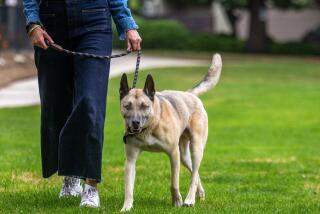Crowning a Cat’s Canine or Filling Fido’s Fangs, It’s All Part of the Job
- Share via
Veterinarian David Nielsen’s interest in animal dentistry began with a Frisbee and a dog.
It happened 17 years ago, shortly after Nielsen had graduated from Kansas State University veterinary school and moved to Manhattan Beach to begin his practice. He was tossing a Frisbee to his dog, a whippet named Kelty, when it broke four of the dog’s teeth.
It was then Nielsen realized that in all his years at veterinary school, he had never learned how to do doggie dental work.
“They used to tell us in veterinary school that if an animal broke a tooth, so be it,” said Nielsen, 40. “At that time there were maybe two veterinarians in the whole country who were doing that kind of specialized dental work, and I’d never heard of them.”
Lacking any alternative, Nielsen took Kelty to his own dentist. The dentist performed the necessary work on Kelty, while Nielsen acted as the anesthesiologist. The results were twofold: Kelty was a happier, healthier dog, and Nielsen developed a lifelong commitment to the long-neglected field of animal dentistry.
“You have to remember that animals feel tooth pain just like we do,” Nielsen said. “And 90% of all dogs and cats have bad teeth at some time in their lives. Maintaining good dental health can have a tremendous impact on your pet’s overall health.”
Today, Nielsen, who owns the Animal Medical Group veterinary clinic in Manhattan Beach, spends most of his time working on animal teeth--mostly dog teeth and cat teeth, although he has done dental work on tigers, chimpanzees and rabbits.
Although many veterinarians do routine teeth cleaning for pets, Nielsen is believed to be one of fewer than 100 in the country with the facilities and expertise to perform sophisticated dental procedures previously reserved for humans--root canals, crowns, bridges, dental implants, even corrective braces.
And it’s not just the pampered pets of movie stars who are getting this kind of sophisticated dental treatment, either. True, Nielsen said he has performed dental work on Elizabeth Taylor’s cat, Al Pacino’s dog and other pet pals of the rich and famous. But Nielsen also does charity work on stray animals in need of homes.
And most of his clients are the pets of regular people who are willing to pay about $130 for a teeth cleaning for a dog, or $200 or more for a root canal, if it means their pet will feel better.
Consider, for example, Jenny the yellow Lab-terrier.
“Jenny’s here for a root canal,” her owner, said Marlys Pratt, 39, a supervisor at Rockwell International, as she and a nervous-looking Jenny waited in an examination room in Nielsen’s Sepulveda Boulevard clinic. Pratt said her regular veterinarian had noticed that 12-year-old Jenny had a broken tooth, and referred her to Nielsen for a root canal. Sure, it’s expensive, and Pratt isn’t rich, but she believes she owes it to Jenny.
“I rescued her from the pound when she was a puppy,” Pratt said, “so I made a commitment to her. Dogs trust you to take care of them.”
Of course, like every dentist since the invention of the high-speed drill, Nielsen said he’d much rather see his patients--or their owners--practice preventive dental care than undergo root canals or other extensive dental work. Unfortunately, he said, too many pet owners don’t pay enough attention to their pets’ teeth.
“A lot of people think they can throw their dog a Milk Bone every morning and that’ll take care of the dog’s teeth,” Nielsen said. “Un uh. That won’t do it. The best thing you can do is brush your pet’s teeth daily. It can make a major difference in your pet’s health, and your wealth.”
In other words, daily brushing of your dog’s teeth can save you from shelling out big bucks for expensive procedures later on. And having teeth that don’t hurt allows your dog to painlessly do the things he loves most--eating, chewing up expensive slippers, biting a mailman, and so on.
Dogs, incidentally, have 42 teeth, Nielsen says; cats have 32.
Brushing an animal’s teeth isn’t as difficult as you might think, Nielsen said. Dogs are especially easy, since you can use a soft-bristled human toothbrush, and many dogs actually like the malt-flavored toothpaste he recommends, which can be swallowed.
“Just stick it (the toothbrush) in there and jiggle it around,” Nielsen said.
Cats are a lot tougher when it comes to brushing, he acknowledged.
“I know a few cat owners who brush their cat’s teeth” with a special kitty toothbrush, Nielsen said, adding that professional teeth cleaning is always done under anesthetic. “But a lot of cats simply won’t allow it.”
Nielsen recommends that you have your pet’s teeth checked, and probably cleaned, at least once a year. That will help catch potential problems early. Staying on top of a pet’s dental care, he said, will have its payoffs.
“Being free from tooth pain can improve your pet’s entire personality,” Nielsen said. “Often it can solve behavioral problems. For me, the most gratifying thing about this is that time after time, after I perform a dental procedure, I’ll get calls from people saying, ‘My dog or my cat is acting like a kitten or a puppy again.’ That’s gratifying.”
More to Read
Sign up for Essential California
The most important California stories and recommendations in your inbox every morning.
You may occasionally receive promotional content from the Los Angeles Times.










